
Leonard Marshall's 1979 MGB with Ford 302 V8 engine
as published in British V8 Newsletter, Volume XIV Issue 3, December 2006(Additional photos and more detailed photo captions added in June 2012.)
Owner: Leonard Marshall
City: San Antonio, TX
Model: 1979 MGB
Engine: Ford 302 V8
Conversion performed by: Owner
Features and Specifications
| Engine: | Ford 302cid engine, with 165 Air Flow Research heads.
The engine was built following specifications from a Car Craft magazine article:
"400 HP with a Stock Cam" by Matthew King.
The only deviations from the article were use of a Holley 685cfm "Street Avenger"
carburetor in lieu of a Demon 625cfm carb, and use of Hedman block-hugger headers in
lieu of Tri-Y headers. I estimate an 8 to 10 HP loss due to the headers, 390+ HP at the
flywheel, and 330-335 HP at the rear wheels! A Vintage-Air "Front Runner" serpentine-belt drive system for the alternator, air conditioning compressor, and water pump shortens engine length by 1-5/9 inches! Custom 180 degree thermostat housing was made and installed for hood clearance. All accessories, valve covers, and the engine compartment are painted in "hammered" black paint. |
| Intake: | Weiand "Stealth" manifold (ported and polished).
Holley "Street Avenger" 685cfm carb with electric choke.
Moroso 14" air cleaner with 1.5"-dropped lower plate.
K@amp;N 2-3/4" tall air filter.
Stock Ford GT roller cam with 1.7:1 ratio Crane roller rockers, for 0.473" lift and 115.5 degree duration.
(Extremely smooth idle and exceptional off-idle response!)
AFR valve springs (both intake and exhaust.) |
| Exhaust: | Hedman block-hugger 4-into-1 headers with 2.5" collectors,
Jet Hot coated both inside and out.
2.5" custom dual exhaust, with H-pipe (see photo).
2.5" Summit turbo mufflers.
(They sound very mellow until you hit the accelerator.)
Fuel tank relocated 1.5" toward the driver's side to provide clearance for twin tailpipes. |
| Ignition: | Mallory Hyfire VI multi-spark (mounted in driver-side footwell).
Mallory dual point distributor with mechanical advance.
(Initial timing is set at 16 degrees, with total advance of 36 degrees at speed.)
Taylor 8mm yellow spark plug wires.
Autolite Iridium (0.06mm) spark plugs, gapped to 0.042". |
| Starting/Charging: | JEGS mini double-reduction starter with heat shielding.
(The starter is the only load on the original cable from the battery.)
Optima dry cell battery.
145 amp single-wire alternator.
A jump-start stud is mounted through the passenger-side inner fender, between
the slam panel and the radiator mounting. |
| Cooling: | Tru-Cool aluminum radiator, 21.5" wide by 19" tall by 2.25" core thickness, with 1" turbulated tubing. Vintage Air 3700cfm electric fan. The fan pulls 27 amps. It's on a separate circuit with a relay and 80 amp maxi-breaker. Power for the fan comes through a 6 gage cable from a battery supply post (i.e. jump-start stud) that's mounted through the right front inner fender. This battery supply post is in-turn supplied by a 2 gauge cable from the battery. An auxiliary radiator, 10" wide by 14" tall by 2.5" core thickness, is mounted in the left rear wheel well with air-flow provided by a 1000cfm Perma-Cool electric fan. Auxiliary 4" electric fans mounted (rated 150cfm each) in the inner fenders help remove air from the engine compartment into the wheel wells. Custom short-shaft high-output water pump (over-driven). |
| A/C System: | All A/C lines are routed through a custom Vintage-Air piping system that runs down
the front of the engine (hidden), under the engine, and into the left wheel well.
The A/C lines are then routed to the condensor, drier, safety switches, and back.
A/C lines are hidden within the car, as are ducts and louvers. |
| Front Susp.: | Stock MGB (rebuilt) with polyurethane bushings throughout. |
| Rear Susp.: | Stock MGB (rebuilt) with polyurethane bushings throughout, plus traction bars and a Panhard rod. |
| Drivetrain: | Ford T5 "World Class" transmission with the following ratios:
1st 3.35:1, 2nd 1.99:1, 3rd 1.33:1, 4th 1.00:1, 5th 0.68:1. Ford 11" diaphragm clutch with Wilwood master cylinder. (Note: a stock MGB slave cylinder was originally fitted, but pedal travel was too long. A Howe pull-type slave will replace it.) Ford 8.8 rear axle (from a 1988 "Turbo Coupe") with 3.73:1 ratio and limited slip differential. The axle has been shortened to 46.25" overall, using Moser 28-spline axle shafts, and is mounted on 1.5" lowering blocks. Custom driveshaft (23.4" long) rated at 450 HP. |
| Brakes: | Front - MGB calipers with drilled-and-grooved rotors and Triumph TR8 pads. Rear - Ford discs (10.5" rotors) and pads. Chrysler master cylinder with 0.822" bore and #2 retention valves. MGB power booster removed. Ratio on pedal changed from 6:1 to 4.5:1. |
| Wheels/Tires: | Front wheels are stock MGB Rostyle type with 185x60R14 Falken tires (130mph rated). Rear wheels are stock MGB Rostyle centers re-mounted into 15" by 8" Stockton rims with 4.75" offset. 225x60R15 Falken tires (130mph rated). Wheel centers have been painted to match car. All four wheels fit within un-modified wheel wells, although the rear is very close. |
| Electrical: | Stock MGB gauges in dash, except Auto-Gauge Tach.
An additional temp gauge and voltmeter have been fitted in the center console.
Sony "Explode" radio with rear-mounted 6" Pioneer speakers.
All electrical loads are relay-switched (10 relays).
Halogen headlights.
Piezo buzzer added to the blinker circuit. |
| Exterior: | Hood modified with a Mustang-style hood scoop for 1.5" of additional clearance to the air cleaner. Over 300 hours of bodywork to create a really smooth car. 1969 Corvette "Daytona Yellow" (PPG 2094) basecoat/clearcoat paint, sprayed by Billy Lieke of Artisan's in San Antonio. (Many thanks to Billy for his guidance on the body work and most of all his friendship!) The paint was rubbed out by Jay Lieke, with the final rub at 4000 grit. |
| Misc. Chassis: | Extra floor crossmembers (12" forward of stock location) and longitudinal reinforcements
(from front leaf spring hangers forward, made from 16-gage steel) added to improve rigidity.
The firewall was extensively modified to allow a 6" engine setback - and to avoid any
modification to the front suspension crossmember.
The stock transmission crossmember was relocated rearward 4.25".
Headers fit without modification. The rear axle bump-stop mounts were removed from the frame to provide extra clearance for the rear wheels/tires. |
| Costs: | The total cost of the project was $17877.28, which includes engine, transmission,
trim/restoration parts, and paint - but doesn't include Leonard's labor. Noteworthy specific costs included: bodyshell (no engine) $1800, engine $1500, aluminum heads $1307, remaining engine parts $593, A/C system $3037, engine electrical $929, transmission $500, rear axle $500, narrowing of axle housing $110, axle shaft shortening $225, driveshaft shortening $121, rear wheel conversion (15") $276, paint (materials) $1047, paint (labor for spraying) $1025, paint (labor for rub-out) $500. |
| Tools Used: | Wire welder, TIG welder, plasma cutter, 48" brake, 48" shear, in-shop post lift, and
a full complement of air tools. |
| Weight: | 2402 pounds, dry. |
| Performance: | Quick! Runs straight in first gear, and gets a little loose on second gear shift, with
equally strong performance in third.
The engine turns 2000rpm at 60mph and redlines at 6200rpm.
Top speed is estimated at 165mph in fifth.
I don't have the coefficient of drag of the MGB so I can't plug it into the computer to
find out if I have sufficient horsepower to achieve 165, but I doubt the car has sufficient
down-force to be stable above 125/130mph. |
| Miles Driven: | 400, as of October 2006. |
| Completed: | June 15, 2006. (Note: project started in 2002.) |
| Comments: | I want to thank my brother, Alan Marshall, for invaluable assistance and also for use
of his shop. This build was complicated by the 6" engine setback, which required elimination of the heater shelf, widening of the transmission tunnel, and altering the footwells (making them narrower by 2-1/2"). The patch panels for this work were formed on a brake from 16 gage steel, and were welded-in all along their perimeter. This actually made the car's body stronger than original. A 1/2" box-section steel tube was welded from the right to left steering protrusions at the firewall and top of the tunnel. The steering shaft had to be custom built and routed through Borgesson steering u-joints, down to the rack-and-pinion. Because of the location of the universal joints and the driveshaft, the original handbrake was removed. It's replacement has not yet been designed. The use of a 21-3/4" wide NASCAR-type radiator created other problems. The car's frame had to be sectioned and reinforced with fabricated gussets to accept the radiator. On a 100 degree day, the engine runs at 170-180 degree water temperature, even with the A/C on. The 8.8" rear axle has a very large center section, and body clearance is minimal with the 1.5" lowering blocks. Two rubber pads were fitted to the center section as bump stops. The Panhard rod is mounted to the same bracket as these pads. I wouldn't suggest this ambitious an engine swap for anyone who doesn't have significant experience and also access to a full shop. |
|
Editor's Note: Leonard's MGB features a particularly well-sorted V8 engine installation. Most
aspects of the original design have proven perfectly reliable and satisfactory. For example,
the engine's cooling system has proven equal to the the task of withstanding summertime weather
in San Antonio, Texas. The photos on this page are from 2006 and 2012 respectively. If you
study the photos carefully, you can see aspects of the car that have been upgraded. Specifically,
the car now has different mufflers than originally described (e.g. glass-pack style mufflers
instead of turbo mufflers). Residual pressure valves have been added to the brake lines, both
front and rear, to improve pedal feel. A different style of front shock absorber is now installed.
A shield has been installed above the engine cooling fan. There may be other changes; the
Features and Specifications text (above) has not been updated.
|
Engine Installation
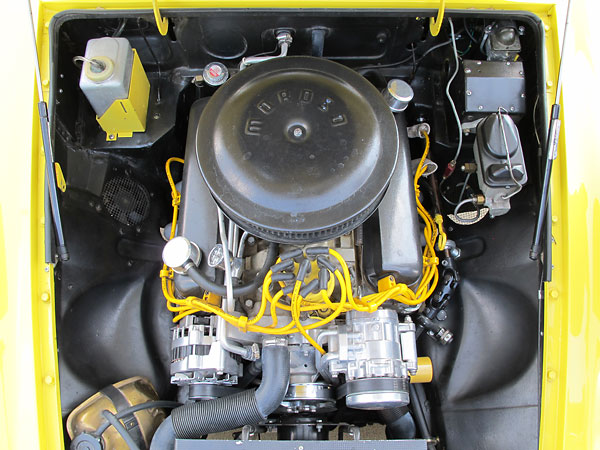
Ford 302cid engine with Air Flow Research model 165 aluminum cylinder heads.

Holley Street Avenger 685cfm carburetor.
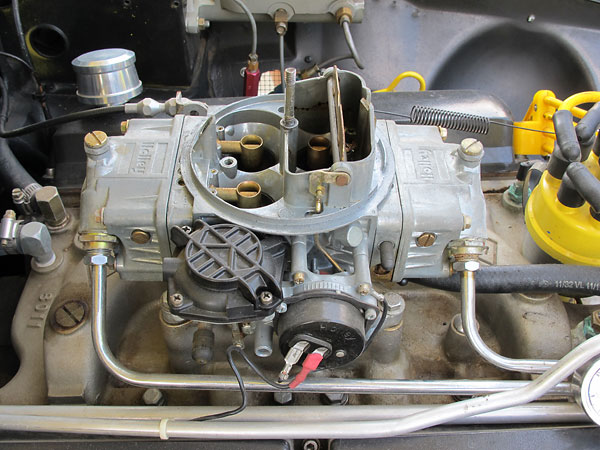
The carburetor has an electric choke mechanism.
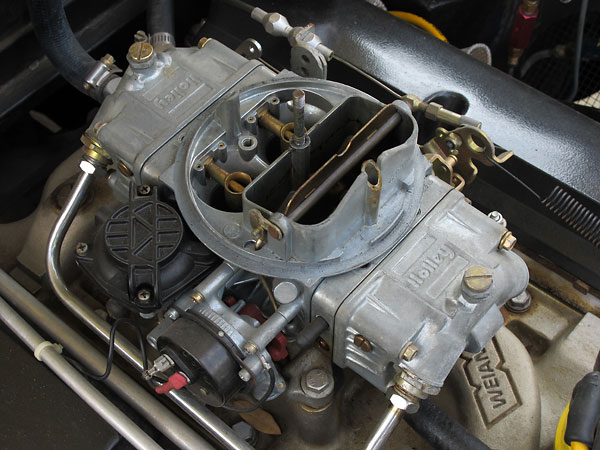
Rearward of the electric choke, the black plastic lid of Holley's Quick Change Adjustable
Vacuum Secondary. (The carb comes with a choice of springs; you can swap between them.)
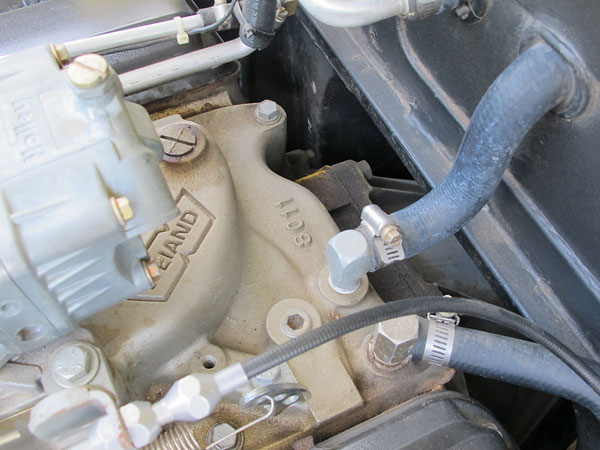
Weiand Stealth intake manifold (ported and polished).

Chrysler master cylinder (0.822" bore). MGB power booster removed. Wilwood residual pressure
valves added. Ratio on pedal changed from 6:1 to 4.5:1.

Steering routed to clear the exhaust. (Photo by Darian Henderson.)

Vintage Air Front Runner serpentine belt and pulley system. Sanden A/C compressor.

145 amp single-wire alternator.
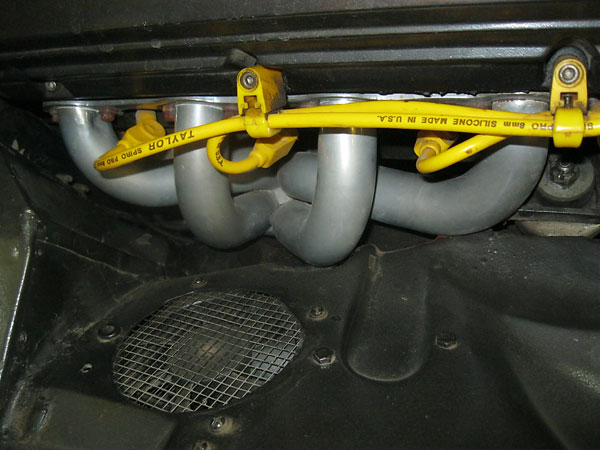
Hedman block-hugger 4-into-1 headers with 2.5" collectors. (Photo by Darian Henderson.)

Headers have been Jet Hot (ceramic) coated, both inside and out.

H-pipe: exhaust crossover pipe.

Ford 8.8 rear axle.
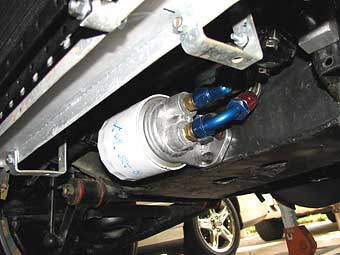


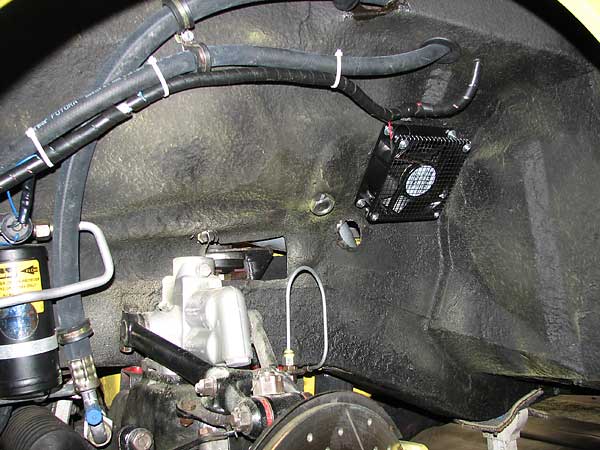

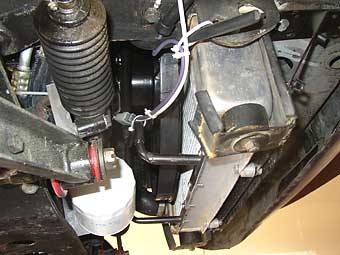

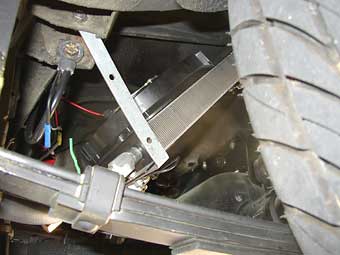


Air conditioning controls.
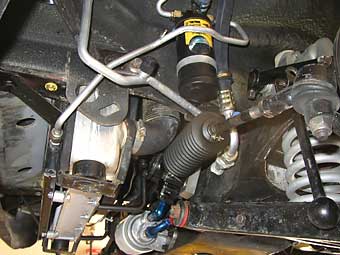

|
Enjoying this article? Our magazine is funded through the generous support of readers like you! To contribute to our operating budget, please click here and follow the instructions. (Suggested contribution is twenty bucks per year. Feel free to give more!) |
Front Suspension
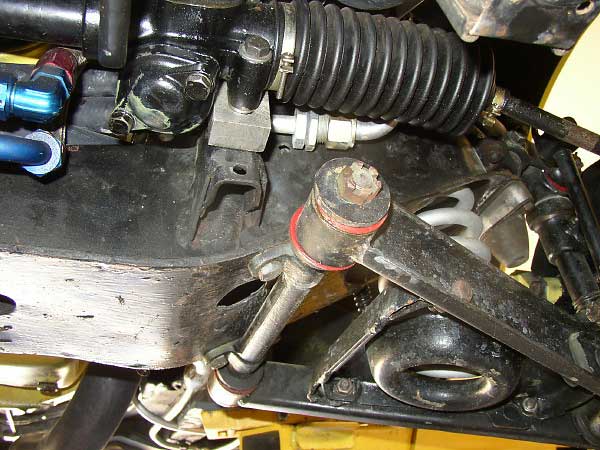
Basically stock MGB suspension, but with red polyurethane bushings in lieu of rubber.
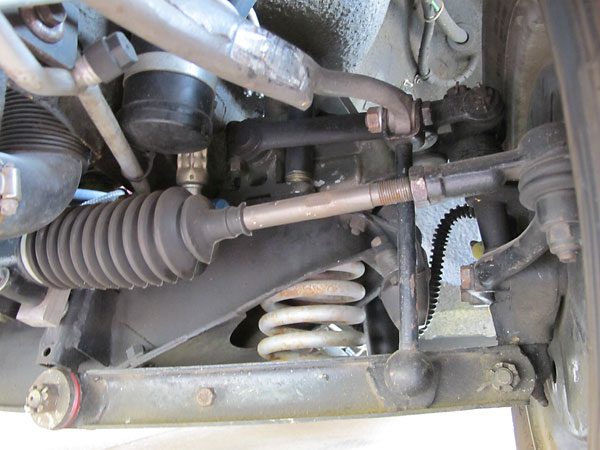
The steering rack has been moved higher to suit current, lowered ride height.
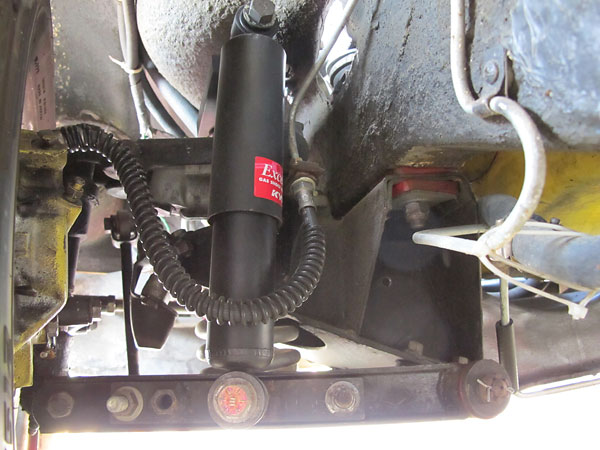
Telescoping shock absorbers are a relatively recent addition.
Rear Suspension
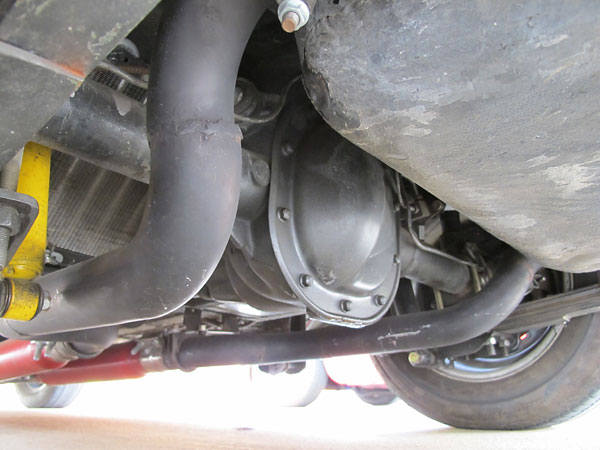
Ford 8.8 rear axle (from a 1988 Turbo Coupe) with 3.73:1 ratio and limited slip differential.
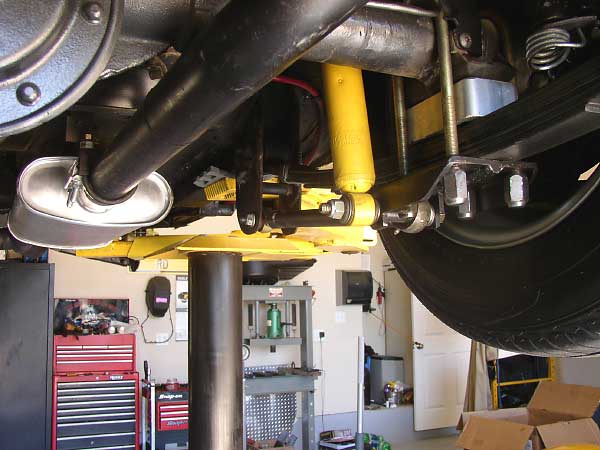


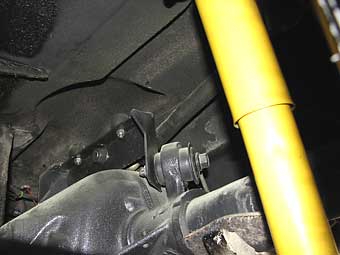
Interior

MGB interior trim. (Photo by Darian Henderson.)

Auto-Gauge tachometer.

Fuse panel and Mallory Hyfire VI multi-spark electronic ignition control box.

A great safety feature: the battery disconnect switch. (Photo by Darian Henderson.)

Rear-mounted 6" Pioneer speakers. (Photo by Darian Henderson.)

Finished trunk, with spare tire. (Photo by Darian Henderson.)

Interior of fiberglass hard top. (Photo by Darian Henderson.)

Hardtop hold-down clamp. (Photo by Darian Henderson.)
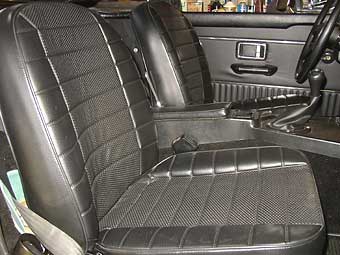

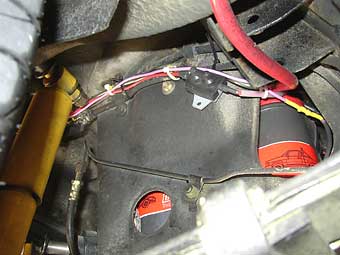



Exterior

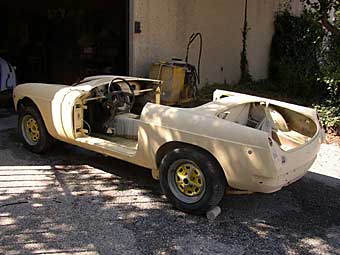

1969 Chevrolet Corvette Daytona Yellow (PPG 2094) basecoat/clearcoat paint
sprayed by Billy Lieke of Artisan's in San Antonio.

A Mustang-style hood scoop provides a generous measure of clearance to the air cleaner.

For comfortable year-round driving, it's nice to have a well-fitting fiberglass hard top.
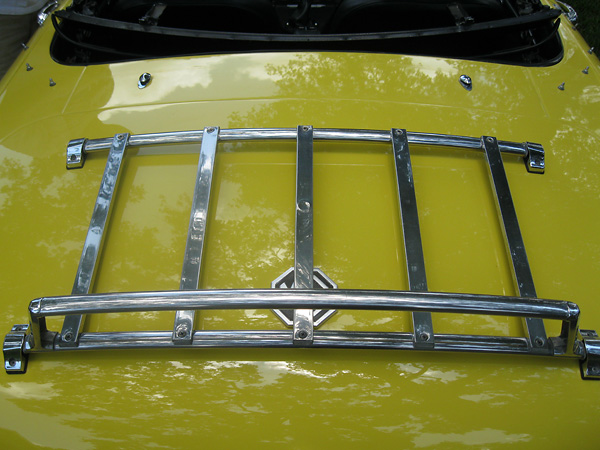
MGB luggage rack. (Photo by Darian Henderson.)
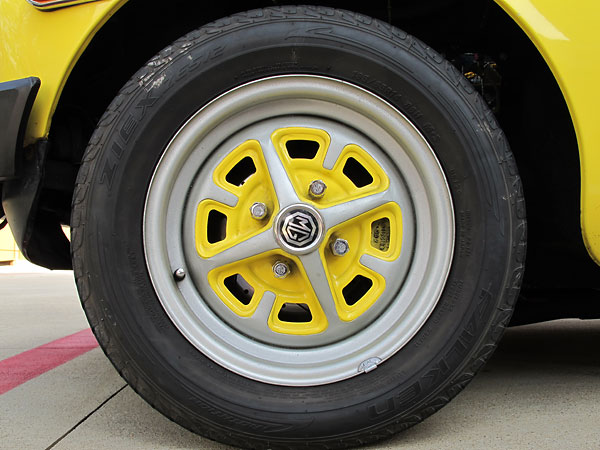
Front wheels are stock MGB Rostyle type with 185x60R14 Falken tires (130mph rated).
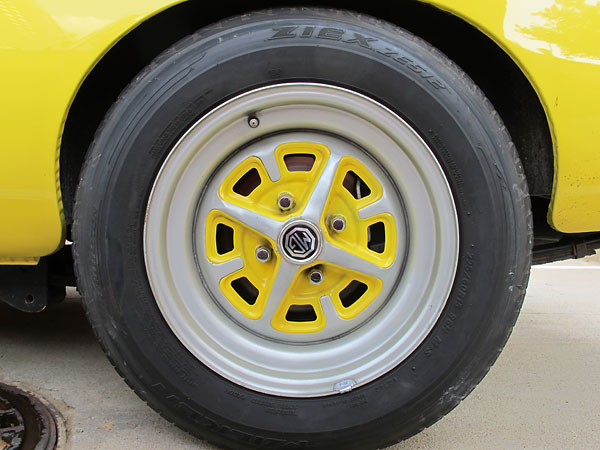
Rear wheels are MGB Rostyle centers re-mounted into 15 by 8 Stockton rims with 4.75" offset.
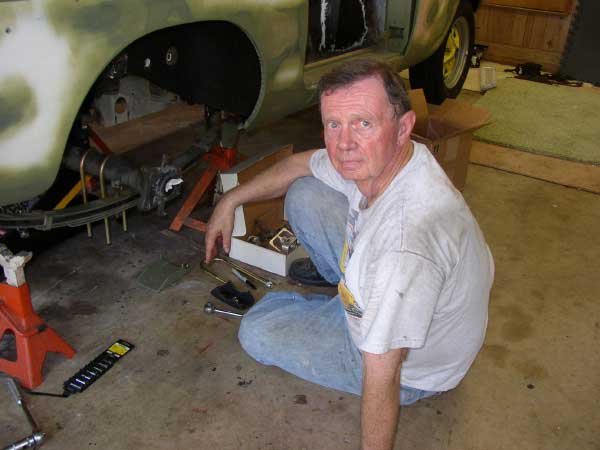
Leonard Marshall

